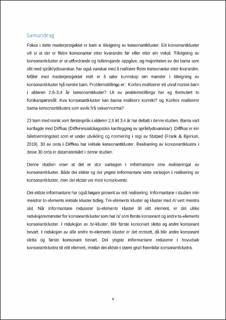| dc.contributor.advisor | Nilsen, Randi Alice | |
| dc.contributor.advisor | Frank, Anne M. | |
| dc.contributor.advisor | Bjerkan, Kirsten M. | |
| dc.contributor.author | Skår-Ekse, Wenche | |
| dc.date.accessioned | 2022-02-04T13:58:28Z | |
| dc.date.available | 2022-02-04T13:58:28Z | |
| dc.date.issued | 2019 | |
| dc.identifier.uri | https://hdl.handle.net/11250/2977232 | |
| dc.description.abstract | Fokus i dette masterprosjektet er barn si tileigning av konsonantkluster. Eit konsonantkluster vil si at det er fleire konsonantar etter kvarandre før eller etter ein vokal. Tileigning av konsonantkluster er ei utfordrande og tidkrevjande oppgåve, og majoriteten av dei barna som slit med språklydsvanskar, har også vanskar med å realisere fleire konsonantar etter kvarandre. Målet med masterprosjektet mitt er å søke kunnskap om mønster i tileigning av konsonantkluster hjå norske barn. Problemstillinga er: Korleis realiserer eit utval norske barn i alderen 2;6-3;4 år konsonantkluster? Ut av problemstillinga har eg formulert to forskarspørsmål: Kva konsonantkluster kan barna realisere korrekt? og Korleis realiserer barna konsonantklustra som avvik frå vaksennorma?
23 barn med norsk som førstespråk i alderen 2;6 til 3;4 år har deltatt i denne studien. Barna vart kartlagde med Diffkas (Differensialdiagostisk kartlegging av språklydsvanskar). Diffkas er ein biletnemningstest som er under utvikling og normering i regi av Statped (Frank & Bjerkan, 2019). 30 av orda i Diffkas har initiale konsonantkluster. Realisering av konsonantklustra i desse 30 orda er datamaterialet i denne studien.
Denne studien viser at det er stor variasjon i informantane sine realiseringar av konsonantkluster. Både dei eldste og dei yngste informantane viste variasjon i realisering av konsonantkluster, men dei eldste var meir konsekvente.
Dei eldste informantane har også høgare prosent av rett realisering. Informantane i studien min meistrar to-elements initiale kluster tidleg. Tre-elements kluster og kluster med /r/ vert meistra sist. Når informantane reduserer to-elements kluster til eitt element, er det ulike reduksjonsmønster for konsonantkluster som har /s/ som første konsonant og andre toelements konsonantkluster. I reduksjon av /s/-kluster, blir første konsonant sletta og andre konsonant bevart. I reduksjon av alle andre to-elements kluster er det motsett, då blir andre konsonant sletta og første konsonant bevart. Dei yngste informantane reduserer i hovudsak konsonantklustra til eitt element, medan dei eldste i større grad forenklar konsonantklustra. | en_US |
| dc.description.abstract | The focus of this master's project is to investigate young children’s acquisition of consonant clusters. A consonant cluster can be defined as a group of consonants pronounced in immediate succession either before or after a vowel. The acquisition of consonant clusters is a challenging and time-consuming task, and the majority of children who struggle with language difficulties, also have difficulty in producing consonants in succession. The aim of my master's project is to acquire knowledge about the normal developmental patterns of acquisition of consonant clusters in Norwegian children. The research question in this assignment is: How do a selection of Norwegian children between the ages of 2;6-3;4 years produce consonant clusters? Based upon this research question I have formulated two further questions: ‘Which consonant clusters can children produce correctly? ’ and ‘In which way does children’s production of consonant clusters deviate from adult norms?’
Twenty-three children, with Norwegian as their first language, aged 2;6 to 3;4 years participated in this study. The children were tested with Diffkas (Differential Diagnostic Survey of Speech Sound Problems). Diffkas is a picture naming test which has been developed and is currently being standardized by Statped (Frank & Bjerkan, 2019). Thirty of the words in Diffkas have consonant clusters in word initial position. The data material in this study is based upon the production of these 30 consonant clusters.
This study shows that there is a large variation in the informants' production of consonant clusters. Both the oldest and the youngest informants showed variation in their realization of consonant clusters, but the older informants were more consistent.
The oldest informants also have a higher percentage of correct productions. The informants in my study master two-element initial clusters early. Three-element clusters and clusters with /r/ were shown to be mastered last. When the informants reduce two-element clusters to one element, a different reduction pattern is seen for consonant clusters having /s-/ as an initial consonant and other two-element consonant clusters. In the reduction of /s/-clusters, the first consonant is deleted and the second consonant is preserved. In the reduction of all other twoelement clusters the opposite occurs, with the first consonant being preserved and the second consonant deleted. The youngest informants tend to reduce consonant clusters into one element, whilst the oldest informants tend to simplify the consonant clusters. | en_US |
| dc.language.iso | nno | en_US |
| dc.publisher | NTNU | en_US |
| dc.subject | Masteroppgave i logopedi | en_US |
| dc.title | Tileigning av konsonantkluster hjå norske 3-åringar | en_US |
| dc.title.alternative | The acquisiton of consonant cluster in Norwegian 3-year-olds | en_US |
| dc.type | Master thesis | en_US |
